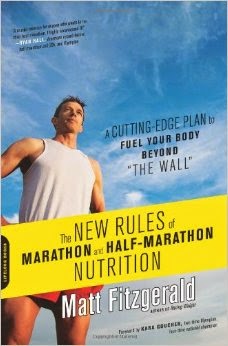Jogging Writer: Training Plan Between Races
I ate whatever I wanted after the race. This included coconut milk ice cream and sweet potato fries. Today, I made a batch of gluten-free chocolate chip cookies. While I’m not one for strict dieting, and while I also feel pretty ok about my overall physical condition, I likewise know the path these enticing cookies head down. I’m not sure it’s one I want to indulge for too terribly long.
Thankfully, Matt Fitzgerald’s New Rules of Marathon and Half-Marathon Nutrition has a chapter that addresses nutrition and exercise recommendations for between races. From reading his earlier work, Racing Weight, I know that my ideal racing weight is 160 pounds and I burn about 1600 calories per day based on my body fat percentage and basal metabolic rate. This information is all I need in order to proceed with his “after race quick start” recommendations and, while I’m slightly burnt out on plans and programs, I’ve come too far to stop now.
So I’ve taken it easy this week, with just 2 workouts and three long walks. I’ve indulged (hence today’s cookies and, forthcoming, Saturday’s cake and champagne at my Bridal Shower). Starting Sunday, I’ll shift gears. Quoting much of Fitzgerald’s well-researched writings, here’s how:
First, create a moderate calorie deficit: “For runners, a moderate calorie deficit is better than a large one…While building fitness may not be your top priority at this time, you’re still working out and trying to lay a foundation for the race-focused training to come. Eating too little would sabotage these efforts. Also, if your calorie deficit is too large you will lose more muscle and less fat than you would with a moderate calorie deficit…If you’re within 10 pounds of your racing weight, 300 calories is sufficient…enabling you to lose weight fairly quickly while preserving muscle mass.”
Second, increase protein intake: “In a 2010 study conducted at the University of Birmingham England, two groups of athletes cut calories equally to promote weight loss. But one group got 15% of its daily calories from protein (which is about normal) while the other group bumped up its protein intake to 35%. The 15% group lost more total weight, but more than half of that weight was lean body mass. Members of the 35% protein group lost just as much fat without losing any muscle…I recommend you aim to get 30 percent of your total calories from protein during [this time]. Increasing your protein intake to this level will necessitate a commensurate reduction in carbohydrate consumption, but that’s not a problem because your training load is relatively low and you are not pursuing maximum performance.”
Third, lift weights: “First, it will give you a more solid musculoskeletal foundation to take into the next training cycle. In addition, much like increased protein intake, a bigger commitment to strength training [during this time] will help you retain muscle and shed only unwanted body fat…I encourage runners to perform three weekly full-body functional strength workouts…Weightlifting is preferable to other forms of strength training such as calisthenics and yoga because it builds more muscle and thereby promotes more fat loss.”
Fourth, do fasting workouts: “Within a race-focused training cycle it is prudent to make every other week’s longest run a ‘fasting workout’ where carbohydrate [ex. Gatorade] is withheld…but during [this time between race trainings] I recommend doing a long fasting run every week. Long runs undertaken at moderate intensity and without carbohydrate intake burn more fat than any other type of run you can do and thus contribute more to your goal of shedding excess body fat.”
Fifth, do very short, very high-intensity intervals: “You can’t maintain maximum training volume year-round or you’ll burn out…So when your training volume is lower, as it is [during this time], you need to burn calories in alternative ways…High-intensity intervals contribute to fat loss by creating a huge post-workout fat-burning effect…I advise runners to perform one full interval workout plus a separate workout with a smaller amount of high-intensity running each week…You can get the strength, speed, power, and fat-loss benefits you seek from maximum-intensity running with less chance of injury if you sprint uphill instead [of sprinting on level ground]. Hill sprints (ten-second efforts) and hill intervals (twenty- or thirty-second efforts) are the two types of interval training I recommend for runners.”
Putting it all together: “Monday–Strength workout. Tuesday–Easy run + hill sprints. Wednesday–Strength workout. Thursday–Hill intervals run. Friday–Strength workout. Saturday–Cycling power intervals. Sunday–Fasting run…Your workout should be quite manageable in the first week and then become gradually more challenging in subsequent weeks.”


